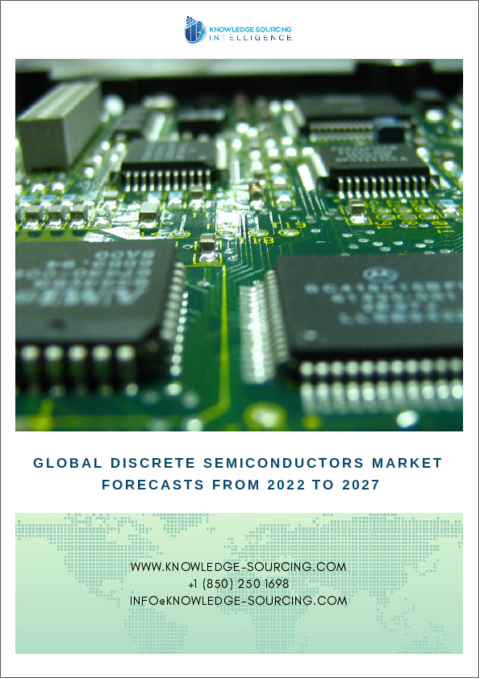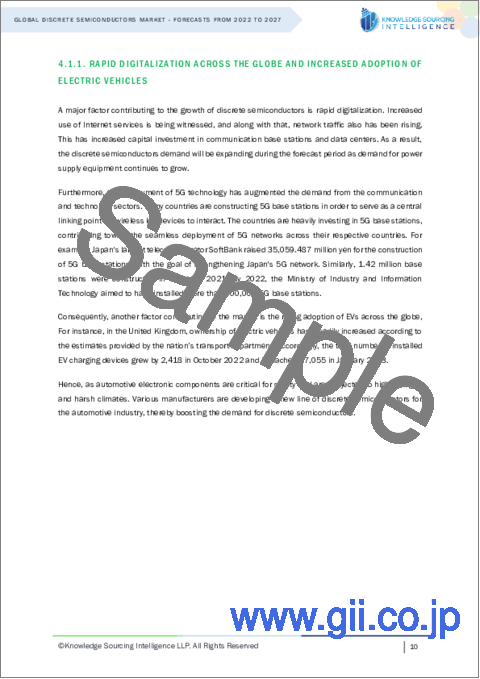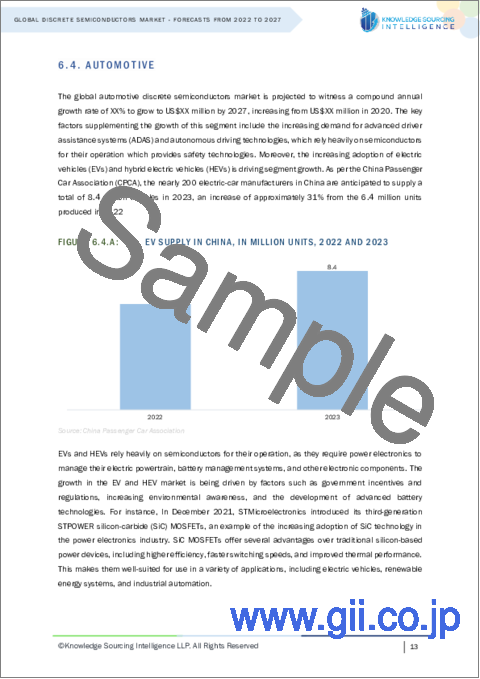|
|
市場調査レポート
商品コード
1171560
ディスクリート半導体の世界市場予測(2022年~2027年)Global Discrete Semiconductors Market - Forecasts from 2022 to 2027 |
||||||
|
● お客様のご希望に応じて、既存データの加工や未掲載情報(例:国別セグメント)の追加などの対応が可能です。 詳細はお問い合わせください。 |
|||||||
| ディスクリート半導体の世界市場予測(2022年~2027年) |
|
出版日: 2022年12月01日
発行: Knowledge Sourcing Intelligence
ページ情報: 英文 132 Pages
納期: 即日から翌営業日
|
- 全表示
- 概要
- 目次
世界のディスクリート半導体の市場規模は、2020年に238億478万1,000米ドルとなり、CAGRで6.22%の成長を示し、2027年に363億823万3,000米ドルになると予測されています。市場を牽引する要因には、回路全体の電力を制御する要求の高まりと小型化や、高電力効率デバイスへのニーズの高まりなどが挙げられます。
当レポートでは、世界のディスクリート半導体市場について調査し、市場規模や予測、COVID-19の影響、市場の促進要因および課題、市場動向、セグメント別の市場分析、競合情勢、主要企業のプロファイルなどの体系的な情報を提供しています。
目次
第1章 イントロダクション
- 市場概要
- COVID-19の影響
- 市場の定義
- 市場セグメンテーション
第2章 調査手法
- 調査データ
- 前提条件
第3章 エグゼクティブサマリー
- 調査のハイライト
第4章 市場力学
- 市場促進要因
- 市場抑制要因
- ポーターのファイブフォース分析
- 供給企業の交渉力
- 買い手の交渉力
- 新規参入者の脅威
- 代替品の脅威
- 競争企業間の敵対関係
- 業界のバリューチェーン分析
第5章 世界のディスクリート半導体市場:タイプ別
- イントロダクション
- サイリスタ
- 整流器
- パワートランジスタ
- 小信号トランジスタ
- ダイオード
- その他
第6章 世界のディスクリート半導体市場:業界別
- イントロダクション
- 家電
- 通信・技術
- 自動車
- 製造
第7章 世界のディスクリート半導体市場:地域別
- イントロダクション
- 南北アメリカ
- 米国
- その他
- 欧州、中東・アフリカ
- ドイツ
- フランス
- その他
- アジア太平洋地域
- 中国
- 日本
- 韓国
- 台湾
- その他
第8章 競合環境と分析
- 主要企業と戦略分析
- 新興企業と市場の有利性
- 合併、買収、契約、コラボレーション
- ベンダーの競合マトリックス
第9章 企業プロファイル
- onsemi
- Vishay Intertechnology, Inc.
- Infineon Technologies AG
- STMicroelectronics
- IXYS Corporation
- Toshiba Corporation
- Diodes Incorporated
- NXP Semiconductors
- Central Semiconductor Corp
- Renesas Electronic Corporation
The global discrete semiconductor market is estimated to grow at a CAGR of 6.22% to reach a market size of US$36,308.233 million by 2027, from US$23,804.781 million in 2020.
A discrete semiconductor device is a single semiconductor system that works a fundamental electronic function. It solely impacts the current flow enclosed in its packaging and performs a single purpose. These components are primarily intended for use with high power and high frequency. Power discrete drives and discrete semiconductors are used in different power supply units for a wide range of electronic uses, from consumer devices to electric charging stations. The growing requirement to control power across circuits and downsizing are driving the discrete semiconductor business. Power dissipation is inversely proportional to package size decrease. During the projected period, the growing need for high-power efficiency devices is likely to drive semiconductor demand. Simultaneously, worldwide demand for wireless and consumer electronics goods is increasing, which is likely to drive demand for discrete semiconductors.
Growth Factors
Because of digital transformation, growth in remote work, and increased use of Internet services, network traffic has been rising. This has spurred investment capital in communication base stations and data centres. Because of this, the market for discrete semiconductors will continue to grow as demand for power supply equipment rises. Data centres and communication base stations are equipped with power semiconductors (diodes) that effectively convert (rectify) the AC power they get from utility companies into DC power since these facilities need a significant quantity of DC power to operate. Moreover, in November 2021, to help data centres and communication base stations save energy, Fuji Electric Co., Ltd. introduced its 2nd-generation discrete SiC-SBD* range of power semiconductors.
With the increased adoption of EVs and HEVs, automotive is one of the rising areas of the discrete semiconductors industry, and it is expected to have a large share.
The market growth for discrete semiconductors can be due to technological advancements like as autonomous car technology, braking systems, and the incorporation of a wide range of sensors (like LiDAR and cameras). Furthermore, government rules mandating advanced driver assistance systems (ADAS) have supported the segment's growth. Automotive electronic components are crucial for safety and are exposed to high voltages and weather conditions. As a result, manufacturers have created a new range of discrete semiconductors for vehicle industries.
Furthermore, consumer electronics make extensive use of discrete semiconductors.
Low-cost availability and attractive incentives are increasing demand for consumer devices, resulting in the increasingly growing market for discrete semiconductors. Furthermore, the top market companies are extensively spending on R&D operations to produce cutting-edge consumer electronics. These factors are also expected to drive market expansion. However, design and steadily growing pricing may limit market expansion. Therefore, all these factors are positively influencing the global discrete semiconductor market.
In addition, due to the extensive and innovative product launches by companies, the global market demand for discrete semiconductors is anticipated to increase in the upcoming years.
Infineon Technologies AG, for example, initiated its high-tech chip production for electrical machines on 300-millimetre thin wafers in Austria, in September 2021, investing a total of EUR 1.6 billion in one of the region's most notable initiatives in the European micro-electronic market. Additionally, Infineon Technologies AG's 650 V CoolSiC Hybrid Discrete for Automotive was released in March 2021. The gadget employs a 50 A TRENCHSTOP 5 fast-switching IGBT and a CoolSiC Schottky diode to provide a cost-effective performance boost while maintaining high reliability. This combination, in addition to bidirectional charging, provides the best cost-benefit trade for hard-switching topologies. In addition, enterprises are creating innovative solutions in the power module area in order to extend their presence and market share.
Market Developments
STMicroelectronics, a prominent semiconductor company dealing with customers across the spectrum of electronics applications, for example, announced the release of its new model of STPOWER silicon-carbide (SiC) MOSFETs1 in December 2021, advancing the condition in power devices for electric-vehicle (EV) powertrains and other implementations in which energy capacity, power efficiency, and durability are key target criteria.
Moreover, Alpha & Omega Semiconductor Limited, a designer, pioneer, and global supplier of power semiconductors, power ICs, and digital energy solutions, will offer AEC-Q101-approved 1200V SiC MOSFETs in an optimized TO-247-4L package in March 2021. It is designed to meet the highly efficient and reliable requirements of EV onboard chargers, motor drive inverters, and off-charging stations. The 1200V SiC MOSFETs have a low on-resistance and a standard gate drive of 15V for an automotive-qualified TO-247-4L. Therefore, all these factors will contribute to the development of the market demand for the coming years.
In January 2022, Vishay Intertechnology Inc. released two new n-channel TrenchFET MOSFETs: the SiJH600E at 60 V and the SiJH800E at 80 V. By combining ultra-low on-resistance with high-temperature functioning to +175 °C and high continuous drain current handling, these improve power density, efficiency, and board-level dependability in telecom and industrial applications.
SEGMENTATION:
By Type
Thyristors
Rectifiers
Power Transistors
Small Signal Transistors
Diodes
Others
By Industry Vertical
Consumer Electronics
Communication
Automotive
Manufacturing
By Geography
Americas
USA
Others
Europe Middle East and Africa
Germany
France
Others
Asia Pacific
China
Japan
South Korea
Taiwan
Others
TABLE OF CONTENTS
1. INTRODUCTION
- 1.1. Market Overview
- 1.2. COVID-19 Scenario
- 1.3. Market Definition
- 1.4. Market Segmentation
2. RESEARCH METHODOLOGY
- 2.1. Research Data
- 2.2. Assumptions
3. EXECUTIVE SUMMARY
- 3.1. Research Highlights
4. MARKET DYNAMICS
- 4.1. Market Drivers
- 4.2. Market Restraints
- 4.3. Porter's Five Force Analysis
- 4.3.1. Bargaining Power of Suppliers
- 4.3.2. Bargaining Power of Buyers
- 4.3.3. Threat of New Entrants
- 4.3.4. Threat of Substitutes
- 4.3.5. Competitive Rivalry in the Industry
- 4.4. Industry Value Chain Analysis
5. GLOBAL DISCRETE SEMICONDUCTORS MARKET, BY TYPE
- 5.1. Introduction
- 5.2. Thyristors
- 5.3. Rectifiers
- 5.4. Power Transistors
- 5.5. Small Signal Transistors
- 5.6. Diodes
- 5.7. Others
6. GLOBAL DISCRETE SEMICONDUCTORS MARKET, BY INDUSTRY VERTICAL
- 6.1. Introduction
- 6.2. Consumer Electronics
- 6.3. Communication and technology
- 6.4. Automotive
- 6.5. Manufacturing
7. GLOBAL DISCRETE SEMICONDUCTORS MARKET, BY GEOGRAPHY
- 7.1. Introduction
- 7.2. Americas
- 7.2.1. USA
- 7.2.2. Others
- 7.3. Europe Middle East and Africa
- 7.3.1. Germany
- 7.3.2. France
- 7.3.3. Others
- 7.4. Asia Pacific
- 7.4.1. China
- 7.4.2. Japan
- 7.4.3. South Korea
- 7.4.4. Taiwan
- 7.4.5. Others
8. COMPETITIVE ENVIRONMENT AND ANALYSIS
- 8.1. Major Players and Strategy Analysis
- 8.2. Emerging Players and Market Lucrativeness
- 8.3. Mergers, Acquisitions, Agreements, and Collaborations
- 8.4. Vendor Competitiveness Matrix
9. COMPANY PROFILES
- 9.1. onsemi
- 9.2. Vishay Intertechnology, Inc.
- 9.3. Infineon Technologies AG
- 9.4. STMicroelectronics
- 9.5. IXYS Corporation
- 9.6. Toshiba Corporation
- 9.7. Diodes Incorporated
- 9.8. NXP Semiconductors
- 9.9. Central Semiconductor Corp
- 9.10. Renesas Electronic Corporation




